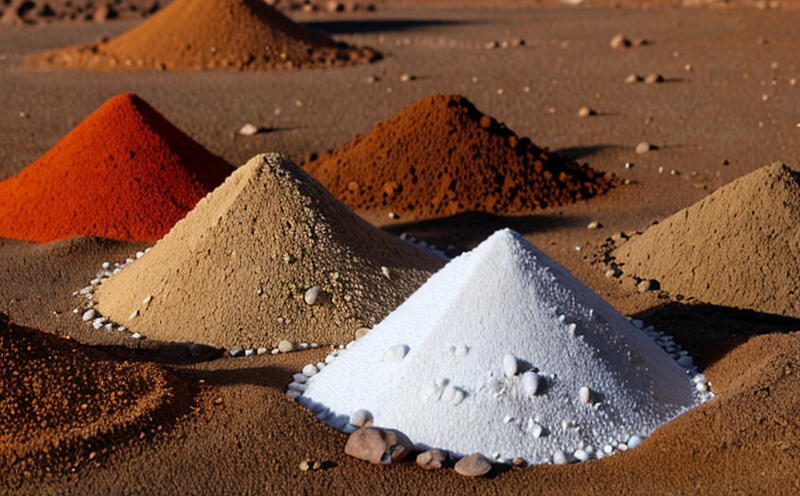ASTM E1404 Chemical Analysis of Lithium Minerals Testing
The ASTM E1404 standard method is a cornerstone in the analysis and quality control of lithium minerals, used extensively by industry professionals to ensure compliance with international standards. This service provides comprehensive chemical analysis tailored specifically for the mining sector, focusing on the accurate determination of lithium content within various mineral samples.
The ASTM E1404 method involves precise sample preparation, dissolution, and subsequent analysis using atomic absorption spectrophotometry (AAS) or inductively coupled plasma optical emission spectroscopy (ICP-OES). These techniques are chosen for their reliability and precision in detecting trace levels of lithium. The process begins with the careful selection and crushing of samples to achieve a homogenous powder suitable for dissolution.
The dissolution step is critical, as it ensures all lithium compounds within the sample are accessible for analysis. This typically involves using hydrofluoric acid (HF) and nitric acid (HNO3), followed by perchloric acid (HClO4). The choice of acids depends on the specific mineral matrix to be analyzed. After dissolution, the solution is filtered and diluted as necessary before being introduced into the analytical instruments.
The analytical process requires a deep understanding of both the sample's composition and potential interferences. Common interferences include calcium, magnesium, and aluminum, which can significantly affect lithium measurements if not properly accounted for. To mitigate these issues, matrix-matched calibration standards are used to ensure accurate results across varying sample types.
ASTM E1404 is recognized globally for its stringent quality control measures and standardized reporting protocols. The method provides detailed instructions on how to prepare samples, which reagents to use, and the acceptable limits of detection (LOD) and quantification (LOQ). This ensures that all laboratories performing ASTM E1404 adhere to a consistent standard.
The test results are reported in parts per million (ppm), with a typical LOD around 5 ppm for lithium. Reporting includes not only the concentration of lithium but also any significant interferences and potential sources of error. This transparency is crucial for ensuring that stakeholders can make informed decisions based on accurate data.
| Step | Description |
|---|---|
| Sample Crushing | The sample is crushed to a fine powder using appropriate equipment. |
| Dissolution | A mixture of hydrofluoric, nitric, and perchloric acids is used for dissolution. |
| Filtering | The filtered solution is diluted to the required concentration. |
The ASTM E1404 method's precision and accuracy are paramount in the mining industry, where even small variations in lithium content can have significant economic implications. By adhering strictly to this standard, laboratories ensure that their data is reliable and comparable across different testing facilities.
Benefits
- Compliance with international standards ensures global market acceptance of mineral products.
- Avoidance of non-compliant materials leading to improved product quality and reduced rework costs.
- Precision in lithium content determination supports informed decision-making in mining operations.
- Accurate reporting enhances transparency, trust, and reputation among stakeholders.
Industry Applications
| Application | Description |
|---|---|
| Exploration and Ore Reserve Estimation | Determining lithium content in potential ore bodies to assess feasibility. |
| Production Control | Monitoring lithium levels during processing to maintain product quality. |
| Quality Assurance and Quality Control | Ensuring consistency in the final product's lithium content for market standards. |
International Acceptance and Recognition
The ASTM E1404 method is widely recognized in the global mining community for its reliability and consistency. It has been adopted by numerous organizations, including the International Organization for Standardization (ISO), to ensure that lithium content measurements are comparable across different laboratories.
Recognized international standards such as ISO 6529:1987, ISO/TS 30413, and ASTM E1404 itself provide a framework for consistent testing protocols. This ensures that the results obtained from ASTM E1404 are universally accepted in regulatory bodies like the United States Environmental Protection Agency (EPA), the European Union's Commission for Chemicals Regulation (ECHA), and other national agencies.
The method is also used by major lithium producers worldwide, including Albemarle Corporation, SQM S.A., and Ganfeng Lithium Co., Ltd. Their adherence to ASTM E1404 underscores the importance of this standard in the industry.





